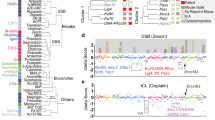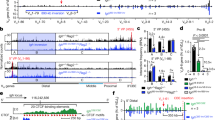Abstract
Immunoglobulin class-switch recombination (CSR) requires activation-induced cytidine deaminase (AID). Deamination of DNA by AID in transcribed switch (S) regions leads to double-stranded breaks in DNA that serve as obligatory CSR intermediates. Here we demonstrate that the catalytic and regulatory subunits of protein kinase A (PKA) were specifically recruited to S regions to promote the localized phosphorylation of AID, which led to binding of replication protein A and subsequent propagation of the CSR cascade. Accordingly, inactivation of PKA resulted in considerable disruption of CSR because of decreased AID phosphorylation and recruitment of replication protein A to S regions. We propose that PKA nucleates the formation of active AID complexes specifically on S regions to generate the high density of DNA lesions required for CSR.
This is a preview of subscription content, access via your institution
Access options
Subscribe to this journal
Receive 12 print issues and online access
$209.00 per year
only $17.42 per issue
Buy this article
- Purchase on Springer Link
- Instant access to full article PDF
Prices may be subject to local taxes which are calculated during checkout






Similar content being viewed by others
References
Jung, D., Giallourakis, C., Mostoslavsky, R. & Alt, F.W. Mechanism and control of V(D)J recombination at the immunoglobulin heavy chain locus. Annu. Rev. Immunol. 24, 541–570 (2006).
Papavasiliou, F.N. & Schatz, D.G. Somatic hypermutation of immunoglobulin genes: merging mechanisms for genetic diversity. Cell 109, S35–S44 (2002).
Chaudhuri, J. et al. Evolution of the immunoglobulin heavy chain class switch recombination mechanism. Adv. Immunol. 94, 157–214 (2007).
Stavnezer, J., Guikema, J.E. & Schrader, C.E. Mechanism and regulation of class switch recombination. Annu. Rev. Immunol. 26, 261–292 (2008).
Peled, J.U. et al. The biochemistry of somatic hypermutation. Annu. Rev. Immunol. 26, 481–511 (2008).
Muramatsu, M. et al. Class switch recombination and hypermutation require activation-induced cytidine deaminase (AID), a potential RNA editing enzyme. Cell 102, 553–563 (2000).
Revy, P. et al. Activation-induced cytidine deaminase (AID) deficiency causes the autosomal recessive form of the hyper-IgM syndrome (HIGM2). Cell 102, 565–575 (2000).
Petersen-Mahrt, S.K., Harris, R.S. & Neuberger, M.S. AID mutates E. coli suggesting a DNA deamination mechanism for antibody diversification. Nature 418, 99–103 (2002).
Ramiro, A.R., Stavropoulos, P., Jankovic, M. & Nussenzweig, M.C. Transcription enhances AID-mediated cytidine deamination by exposing single-stranded DNA on the nontemplate strand. Nat. Immunol. 4, 452–456 (2003).
Chaudhuri, J. et al. Transcription-targeted DNA deamination by the AID antibody diversification enzyme. Nature 422, 726–730 (2003).
Dickerson, S.K., Market, E., Besmer, E. & Papavasiliou, F.N. AID mediates hypermutation by deaminating single stranded DNA. J. Exp. Med. 197, 1291–1296 (2003).
Bransteitter, R., Pham, P., Scharff, M.D. & Goodman, M.F. Activation-induced cytidine deaminase deaminates deoxycytidine on single-stranded DNA but requires the action of RNase. Proc. Natl. Acad. Sci. USA 100, 4102–4107 (2003).
Tian, M. & Alt, F.W. Transcription-induced cleavage of immunoglobulin switch regions by nucleotide excision repair nucleases in vitro. J. Biol. Chem. 275, 24163–24172 (2000).
Yu, K., Chedin, F., Hsieh, C.L., Wilson, T.E. & Lieber, M.R. R-loops at immunoglobulin class switch regions in the chromosomes of stimulated B cells. Nat. Immunol. 4, 442–451 (2003).
Shinkura, R. et al. The influence of transcriptional orientation on endogenous switch region function. Nat. Immunol. 4, 435–441 (2003).
Schrader, C.E., Edelmann, W., Kucherlapati, R. & Stavnezer, J. Reduced isotype switching in splenic B cells from mice deficient in mismatch repair enzymes. J. Exp. Med. 190, 323–330 (1999).
Rada, C. et al. Immunoglobulin isotype switching is inhibited and somatic hypermutation perturbed in UNG-deficient mice. Curr. Biol. 12, 1748–1755 (2002).
Rada, C., Di Noia, J.M. & Neuberger, M.S. Mismatch recognition and uracil excision provide complementary paths to both Ig switching and the A/T-focused phase of somatic mutation. Mol. Cell 16, 163–171 (2004).
Bardwell, P.D. et al. Altered somatic hypermutation and reduced class-switch recombination in exonuclease 1-mutant mice. Nat. Immunol. 5, 224–229 (2004).
Chaudhuri, J., Khuong, C. & Alt, F.W. Replication protein A interacts with AID to promote deamination of somatic hypermutation targets. Nature 430, 992–998 (2004).
Shen, H.M., Peters, A., Baron, B., Zhu, X. & Storb, U. Mutation of BCL-6 gene in normal B cells by the process of somatic hypermutation of Ig genes. Science 280, 1750–1752 (1998).
Pasqualucci, L. et al. Hypermutation of multiple proto-oncogenes in B-cell diffuse large-cell lymphomas. Nature 412, 341–346 (2001).
Liu, M. et al. Two levels of protection for the B cell genome during somatic hypermutation. Nature 451, 841–845 (2008).
Ramiro, A.R. et al. AID is required for c-myc/IgH chromosome translocations in vivo. Cell 118, 431–438 (2004).
Unniraman, S., Zhou, S. & Schatz, D.G. Identification of an AID-independent pathway for chromosomal translocations between the Igh switch region and Myc. Nat. Immunol. 5, 1117–1123 (2004).
Ramiro, A.R. et al. Role of genomic instability and p53 in AID-induced c-myc-Igh translocations. Nature 440, 105–109 (2006).
Pasqualucci, L. et al. AID is required for germinal center-derived lymphomagenesis. Nat. Genet. 40, 108–112 (2008).
Muramatsu, M. et al. Specific expression of activation-induced cytidine deaminase (AID), a novel member of the RNA-editing deaminase family in germinal center B cells. J. Biol. Chem. 274, 18470–18476 (1999).
Dorsett, Y. et al. MicroRNA-155 suppresses activation-induced cytidine deaminase-mediated Myc-Igh translocation. Immunity 28, 630–638 (2008).
Teng, G. et al. MicroRNA-155 is a negative regulator of activation-induced cytidine deaminase. Immunity 28, 621–629 (2008).
Aoufouchi, S. et al. Proteasomal degradation restricts the nuclear lifespan of AID. J. Exp. Med. 205, 1357–1368 (2008).
Basu, U. et al. The AID antibody diversification enzyme is regulated by protein kinase A phosphorylation. Nature 438, 508–511 (2005).
Pasqualucci, L., Kitaura, Y., Gu, H. & Dalla-Favera, R. PKA-mediated phosphorylation regulates the function of activation-induced deaminase (AID) in B cells. Proc. Natl. Acad. Sci. USA 103, 395–400 (2006).
McBride, K.M. et al. Regulation of hypermutation by activation-induced cytidine deaminase phosphorylation. Proc. Natl. Acad. Sci. USA 103, 8798–8803 (2006).
McBride, K.M. et al. Regulation of class switch recombination and somatic mutation by AID phosphorylation. J. Exp. Med. 205, 2585–2594 (2008).
Chatterji, M., Unniraman, S., McBride, K.M. & Schatz, D.G. Role of activation-induced deaminase protein kinase A phosphorylation sites in Ig gene conversion and somatic hypermutation. J. Immunol. 179, 5274–5280 (2007).
Shinkura, R., Okazaki, I.M., Muto, T., Begum, N.A. & Honjo, T. Regulation of AID function in vivo. Adv. Exp. Med. Biol. 596, 71–81 (2007).
Zhong, H. SuYang, H., Erdjument-Bromage, H., Tempst, P. & Ghosh, S. The transcriptional activity of NF-κB is regulated by the IκB-associated PKAc subunit through a cyclic AMP-independent mechanism. Cell 89, 413–424 (1997).
Basu, U., Wang, Y. & Alt, F.W. Evolution of phosphorylation-dependent regulation of activation-induced cytidine deaminase. Mol. Cell 32, 285–291 (2008).
Shabb, J.B. Physiological substrates of cAMP-dependent protein kinase. Chem. Rev. 101, 2381–2411 (2001).
Pokholok, D.K., Zeitlinger, J., Hannett, N.M., Reynolds, D.B. & Young, R.A. Activated signal transduction kinases frequently occupy target genes. Science 313, 533–536 (2006).
Kim, C., Cheng, C.Y., Saldanha, S.A. & Taylor, S.S. PKA-I holoenzyme structure reveals a mechanism for cAMP-dependent activation. Cell 130, 1032–1043 (2007).
Howe, D.G. et al. Inhibition of protein kinase A in murine enteric neurons causes lethal intestinal pseudo-obstruction. J. Neurobiol. 66, 256–272 (2006).
Kraus, M., Alimzhanov, M.B., Rajewsky, N. & Rajewsky, K. Survival of resting mature B lymphocytes depends on BCR signaling via the Igα/β heterodimer. Cell 117, 787–800 (2004).
Odegard, V.H. & Schatz, D.G. Targeting of somatic hypermutation. Nat. Rev. Immunol. 6, 573–583 (2006).
Cheng, H.-L. et al. Integrity of AID serine-38 phosphorylation site is critical for class switch recombination and somatic hypermutation in mice. Proc. Natl. Acad. Sci. USA (in the press).
Zarrin, A.A. et al. Antibody class switching mediated by yeast endonuclease generated DNA breaks. Science 315, 377–381 (2007).
Lin, Y.C., Shockett, P. & Stavnezer, J. Regulation of transcription of the germline immunoglobulin alpha constant region gene. Curr. Top. Microbiol. Immunol. 182, 157–165 (1992).
Reina-San-Martin, B et al. H2AX is required for recombination between immunoglobulin switch regions but not for intra-switch region recombination or somatic hypermutation. J. Exp. Med. 197, 1767–1778 (2003).
Van Parijs, L. et al. Uncoupling IL-2 signals that regulate T cell proliferation, survival, and Fas-mediated activation-induced cell death. Immunity 11, 281–288 (1999).
Nambu, Y. et al. Transcription-coupled events associating with immunoglobulin switch region chromatin. Science 302, 2137–2140 (2003).
Ju, B.G. et al. A topoisomerase IIβ-mediated dsDNA break required for regulated transcription. Science 312, 1798–1802 (2006).
Dignam, J.D., Lebovitz, R.M. & Roeder, R.G. Accurate transcription initiation by RNA polymerase II in a soluble extract from isolated mammalian nuclei. Nucleic Acids Res. 11, 1475–1489 (1983).
Acknowledgements
We thank T. Honjo (Kyoto University) for AID-deficient mice; J. Allison (Memorial Sloan-Kettering Cancer Center) for anti-CD3 and anti-CD28; P. Rothman (University of Iowa) for the plasmid pMIG-hPim1; and L. Denzin and D. Sant'Angelo, as well as members of their laboratories and members of the Chaudhuri laboratory, for discussions and technical assistance. Supported by the US National Institutes of Health (T32CA09149 to B.V.), the Damon Runyon Cancer Research Foundation (J.C.), the Bressler Scholars Foundation (J.C.), the Frederick Adler Chair for Junior Faculty (J.C.) and the Sloan-Kettering Institute (J.C.).
Author information
Authors and Affiliations
Corresponding author
Supplementary information
Supplementary Text and Figures
Supplementary Figures 1–19, Table 1 and Supplementary Methods (PDF 1167 kb)
Rights and permissions
About this article
Cite this article
Vuong, B., Lee, M., Kabir, S. et al. Specific recruitment of protein kinase A to the immunoglobulin locus regulates class-switch recombination. Nat Immunol 10, 420–426 (2009). https://doi.org/10.1038/ni.1708
Received:
Accepted:
Published:
Issue Date:
DOI: https://doi.org/10.1038/ni.1708
This article is cited by
-
Functions and consequences of AID/APOBEC-mediated DNA and RNA deamination
Nature Reviews Genetics (2022)
-
AICDA drives epigenetic heterogeneity and accelerates germinal center-derived lymphomagenesis
Nature Communications (2018)
-
Immuno-engineered organoids for regulating the kinetics of B-cell development and antibody production
Nature Protocols (2017)
-
AID expression increased by TNF-α is associated with class switch recombination of Igα gene in cancers
Cellular & Molecular Immunology (2016)
-
Mutations, kataegis and translocations in B cells: understanding AID promiscuous activity
Nature Reviews Immunology (2016)



